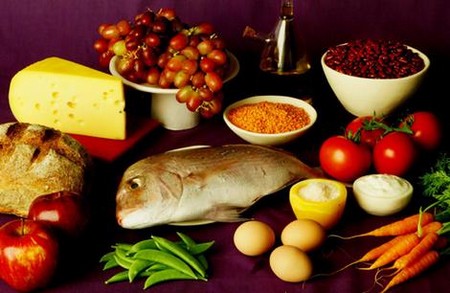An important part of planning meals is going to the grocery store and buying the ingredients for what you’ve planned to eat. “Come on,” you may be thinking, “I’ve been doing the family food shopping for longer than I want to think about. I know the store by heart and there’s nothing you can tell me about how to shop.”
This may be true, but have you ever turned the package over and read a food label? Or if you have, have you ever gone beyond the calorie count? Most people don’t, but now that you have diabetes, it’s a good idea to learn how. Luckily for all of us, in 1994, the Food and Drug Administration redesigned and standardized the labels so that each manufacturer of prepared food must use the same format. The new law applies to all foods manufactured in the United States and to those imported for sale here. Every label must show how much total carbohydrate (including dietary fiber and sugars), sodium, cholesterol, and fat a product contains, and it must list the amount of saturated fat, protein, minerals, Vitamins A and C, and—perhaps most important—the total calories and calories from fat.

Let’s go through the major elements of a food label:
Content versus percent of daily value
The top part of the label lists nutrients as a percentage of what an average person requires based on a two-thousand calorie diet, and the bottom part of the label lists the actual amount of a nutrient in that particular package. For diabetics, the top is a general guide, and the bottom is an essential part of your food plan.
Serving size
I have always thought that food manufacturers must believe that they are packaging their products for a flock of birds because the serving size is always so small. Who eats a half cup of chocolate pudding? You might—when you look at the number of calories in a serving size that looks like only a thimbleful in your dish. You might also decide it’s not worth your while to spend that many calories on such a little bit of prepared food. You might also realize that it’s too hard for you to eat only a half cup, and you might be tempted to end up finishing the entire container. Whatever your eating habits and food preferences, be sure you note the serving size and have a good idea of what half a cup looks like on a plate—or you could actually measure it. The amount of nutrients described on the label refer to each serving, not to the entire container.
Total carbohydrates
This should be a major focus of your attention. Remember that it is the total amount of carbohydrates you consume, rather than individual kinds of sugar and starch, that affects your blood glucose.
- Types of fat. Choose foods that have the lowest percentage and total amount of saturated fat.
- Ingredients. The ingredients of the food in a package are listed in descending order by weight. The first four or five items are usually the major ingredients, and the rest are flavorings and chemicals used as preservatives. Therefore, it’s important when buying prepared foods such as frozen dinners to see what they actually contain so you can match them to your meal plan. In addition, the picture on most packages provides a fairly accurate idea of what you will find inside, although it won’t taste nearly as good as it looks.
As you get into the habit of reading labels, you’ll come across some terms that you’ve never heard before or that you don’t know the meaning of. Many items on the supermarket shelf have the words “healthy” or “natural,” most of which have no regulatory meaning. The federal government (the Department of Agriculture regulates labels on meat and poultry products and the Food and Drug Administration regulates seafood, processed food, dairy products, and produce) controls what manufacturers are allowed to claim about their products. Here’s what the label terms mean:
- Low fat: no more than 3 grams of fat per serving for individual foods, and no more than 30 percent of calories from fat for complete meals
- Low in saturated fat: no more than 1 g of saturated fat per serving, and no more than 15 percent of total calories from saturated fat
- Fat free: less than 0.5 g of fat per serving
- Low sodium: 140 mg or less per serving
- Sodium free: less than 5 mg of sodium per serving
- Light (Lite): one-third fewer calories or 50 percent less fat per serving
- Low cholesterol: no more than 20 mg of cholesterol and 2 g or less of saturated fat per serving
- Cholesterol free: less than 2 mg of cholesterol and 2 g or less of saturated fat per serving
- Reduced/less: contains 25 percent or less of a nutrient than a comparable food
- Low calorie: no more than 40 calories per serving
- Sugar free: less than 0.5 gram of sugar per serving
- Dietetic: does not necessarily mean the item is good for you; it means that something has been changed or replaced in the food: salt, sugar, total fat, or cholesterol
- Natural: in regard to meat and poultry it means that no chemical preservatives or hormones have been added; for other foods this has no regulatory meaning
You also need to know how to figure the percentage of calories from fat. Here you need to use a little arithmetic, but it’s not hard—and it is important. Because each gram of fat contains 9 calories, all you do is multiply the grams of fat per serving (it’s right on the label) by 9 and then divide this number by the total number of calories in each serving. To convert to a percentage, multiply by 100.

For example, a food that contains 4 grams of fat and 100 calories per serving is calculated as follows:
4 grams of fat x 9 = 36 fat calories
36 -5- 200 (calories per serving) – 0.36
0.36 x 100 = 36% of the calories comes from fat